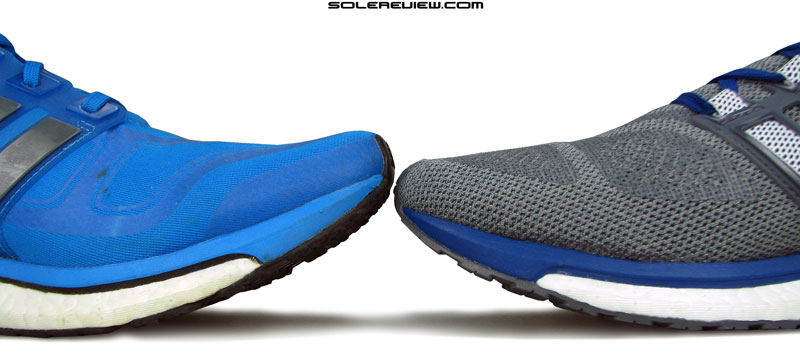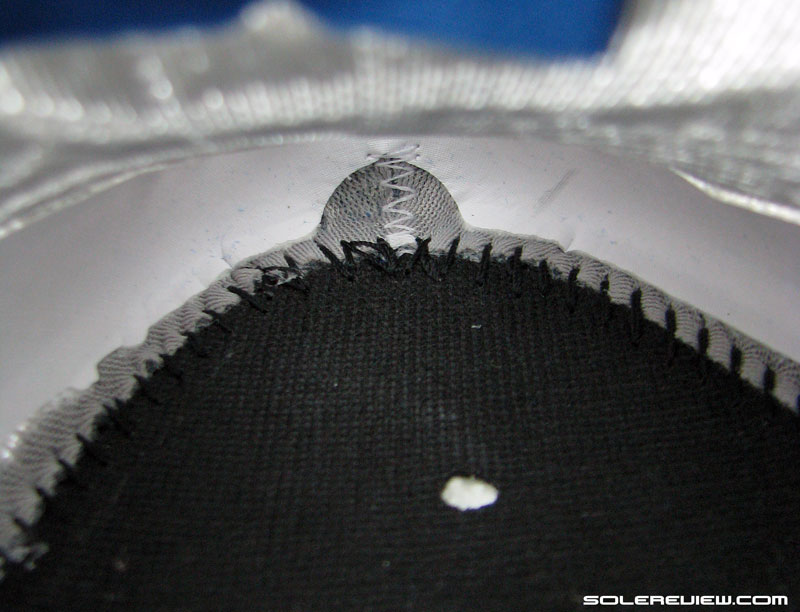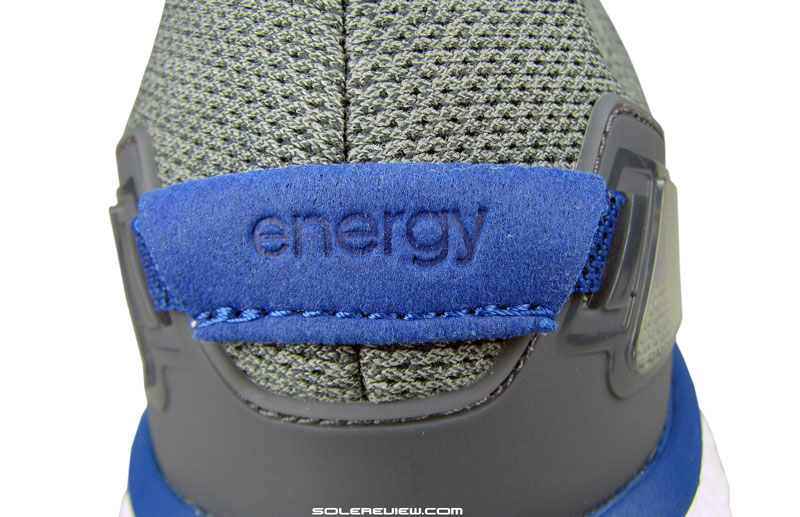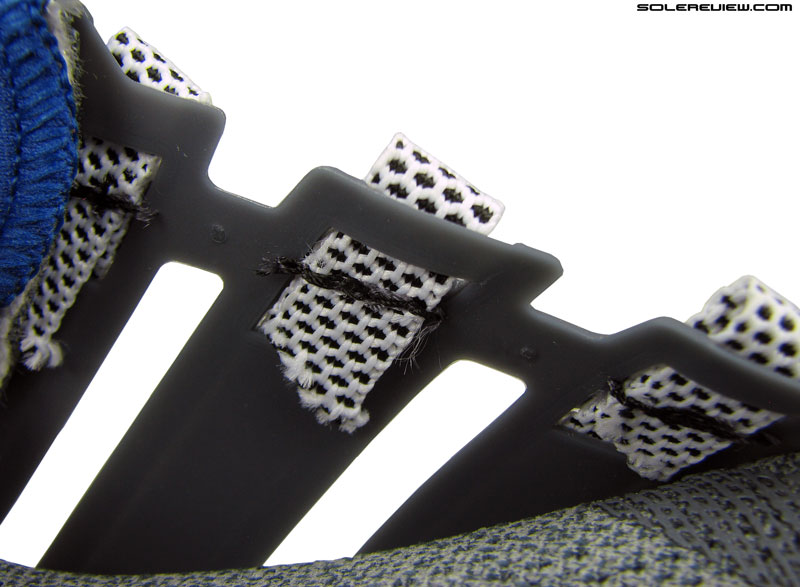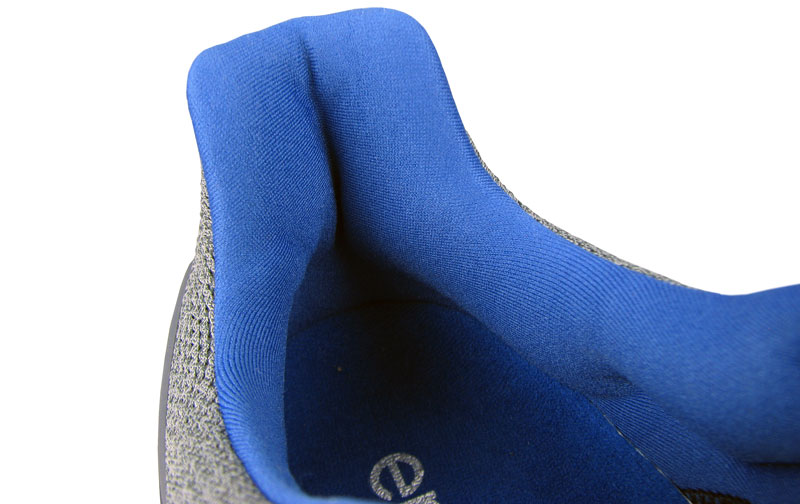Most brands have their release calendar or cadence down pat. You know that Asics will push their updated versions of the Nimbus, Kayano and other models to the market each year and Brooks has their own steady model flow going on. But speak of adidas, and their release cadence is still a bit foggy.
For example, the adidas Glide and Sequence come dressed in new livery each year. When it comes to the rest of the Boost pack, the calendar is clear as mud. For example, the chronological gap between the EB2 and EB3 suggests that the update process is a biennial event. But didn’t the EB2 show up a year after the first Energy Boost? So which one of the two is it?
Likewise for models such as the adios and Boston Boost. It is very common for speed shoes to have a longer update cycle, but the consistency would need to be agreed on. The once-in-two-years update also seems to apply to the Boston Boost, but hey, didn’t the women’s color get a Boston Boost 6 last year, while the men’s version was left out? What gives?
You see what solereview is getting at. One of the other things which adidas seems to be struggling with is the aspect of differentiation across its Boost infused models. For example, for someone who isn’t very tuned into footwear technicalities, how does one explain the premium the Energy or Glide Boost has over the cushioned (and less expensive) Response Boost?
And in the upper echelons of price-bands, how is an Ultra Boost different from an Energy Boost? The upper might be Primeknit and all that, but is hard to put a price to the variation in ride quality. Both models share a lot of common aspects when it comes to the midsole behavior.
As adidas is finding it out the hard way, its greatest weapon is also its biggest feature equalizer or differentiation killer. Once you plug in a heel-to-toe Boost midsole of a respectable volume, then it becomes a bit hard to tell shoes apart – at least from a price-value trickle up/down viewpoint.
The Boost foam is also a challenge from a design perspective. As of now, it comes in only one color, and since it feels so much different than regular foam (in a good way), it is hard to mix and match Boost with foam sidewalls or wedges.
If you wall up the sides with regular foam (read our Sonic Boost review), then the result is a ride which robs much of Boost’s uniqueness. So for most of its shoes, adidas has wisely chosen to layer sections of EVA foam vertically instead of horizontally. Yet the end result of this is that all the midsoles start looking the same from a distance.
This constraint is the reason why adidas has left the general midsole aesthetic untouched. In some cases – like the Glide and Sequence Boost – the entire design is carried forward. The Glide Boost has had the same midsole for three years in a row now. The Sequence 9 will update its midsole design this year, but it will continue to maintain its visual look and feel package.
The 2016 Energy Boost 3 does the same thing as the soon-to-be-released Sequence 9, tweaking its sole design with such subtlety that it ends up looking the same (mostly) as the EB2. The outsole material no longer has the ‘adiwear’ text near the heel edge, which isn’t very reassuring.
After all, some of adidas’s models (Glide 8) have the most durable outsoles to have ever existed, and the EB2 did very well too in that regards. Even if the EB3’s outsole was made of the adiwear rubber compound, skimping on the logo detail is a design oversight.
People need to know what they’re buying – adidas’s webpage of the Energy Boost is pretty vague, saying that the EB has ‘a grippy rubber outsole with increased cushioning’. The Energy Boost 3 already has a voluminous Boost midsole; so how much more cushioning does one need?
The omission of the adiwear call-out isn’t the only change. While the Energy Boost 2 left the Boost foam under the heel and forefoot exposed, the EB3 does a cover-up job this year.
The ‘not-sure-if-adiwear’ rubber covers most of the Boost area, except under the center, where it is bridged by the plastic Torsion shank.
And in the way of the previous Energy Boost, the shank extends under the forefoot and the medial/inner side outsole.
Sandwiched in the middle is the EB’s pièce de résistance, the resilient Boost material. Volume for volume, there appears to be no difference between the EB2 and EB3’s Boost midsole.
However, the Boost foam in the EB3 does feel slightly easier to compress than the EB2, but that could be due to acceptable manufacturing variances between different batches of production.
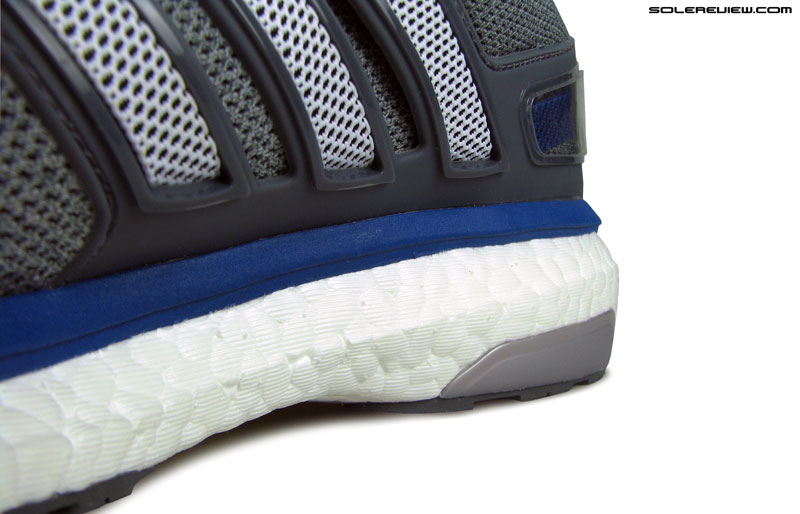
The blue EVA strip is a rim over the midsole edge, and does not insulate the foot from the Boost foam.
The Energy Boost uses a firm EVA rim going around the midsole edge. Unlike the Glide Boost where the EVA sheet actually goes on top of the midsole, the rim on the EB is confined to only the edge.
That said, the lasting material over the midsole has changed on the EB3.
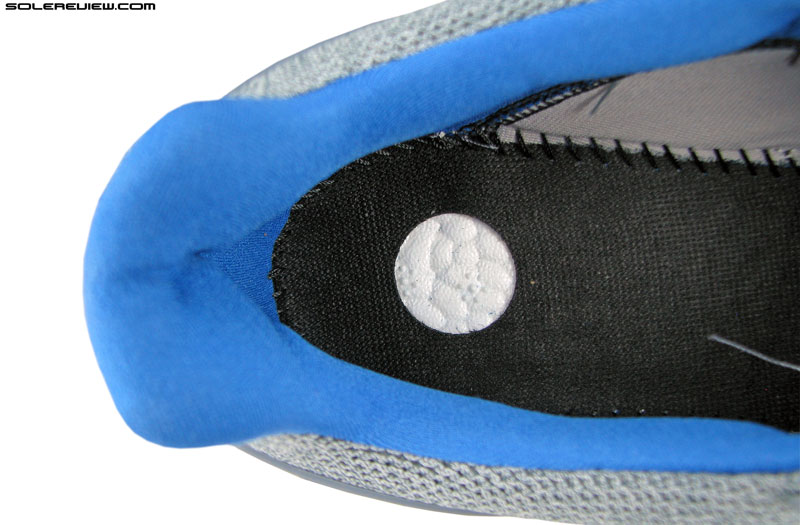
Pity, adidas has replaced the gorgeous looking synthetic with this tasteless fabric. By the way, this circular hole was larger on the EB2.
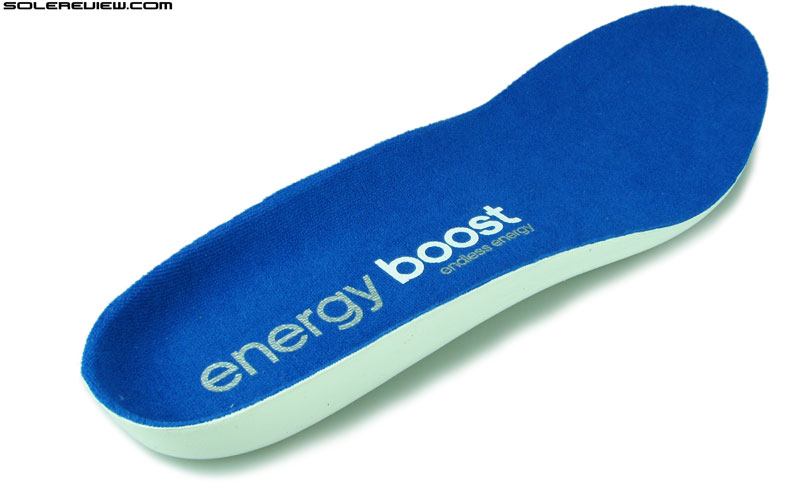
A cup-molded insole is inside the Energy Boost 3. Same as the EB2’s version, except for a different color.
The 2014 Energy Boost 2 used a nice translucent synthetic over the Boost foam. So if you removed the foam insole, the combination of this green-hued sheet and Boost foam presented a pretty cool sight. Well, there’s none of that fun anymore, because adidas has replaced that gorgeous translucency with a boring piece of fabric used on their cheaper models.
The consolation is that the removable insole hasn’t changed in design or thickness from the EB2. It remains the cushy piece of compression molded EVA foam, topped with a comfortable fabric.
As far as the ride is concerned, the Energy Boost 3 runs firmer than the last model. It doesn’t take long to realize why; for starters, it is because of the reduced area of exposed Boost foam below the midsole.
Barring the Torsion midfoot shank, the new design of the outsole covers the near entirety of the underside, hence dulling the Boost effect. The side-by-side comparison of the two outsole designs shows that very clearly.
On the EB2, the exposed Boost midsole under the heel actually made contact with the ground – notice the scuffed part. The EB2 forefoot, even with the plastic Torsion ‘fingers’ extending forward, had more bounce than the EB3. Simply put, the EB2 outsole design allowed the Boost midsole to better perform as a cushioning agent, thus increasing responsive feel.
The lasting material over the midsole has an impact too. The circular cut-out over the EB2’s heel was larger in diameter than the EB3, and the green lasting material was also very thin over the EB2’s forefoot. Both these factors made the Boost foam easier to access.
So while the Energy Boost 3 has the trademark cushioning feel, it somehow doesn’t feel as connected to the ground as the EB2 does. On the EB2, the translucent (and somewhat flexible) lasting and the open design approach of the outsole worked seamlessly with the springy Boost foam. That character is conspicuous by its absence on the Energy Boost 3.
When put toe-to-toe, the EB3 has a much lower toe spring than the EB2. And we believe that it’s got more to do with the Energy Boost’s upper than the sole design, as the tighter Techfit mesh of the EB2 pulled the outsole tip inwards.
So this means that the EB3’s ‘techfit’ fabric has changed, yes? Correct.
If you remember the Energy Boost 2, it came in two mesh flavors. One was the spandex like ‘Techfit’ and the other version was a relatively easygoing ESM version. In other words, the new ‘Techfit’ of the EB3 is the old ESM.
Though the latest techfit iteration does have stretch properties, it is nowhere as snap-fitting as the Techfit 1.0 was.
The EB3’s forefoot is supported with some high density rubber printing, and an internal toe-bumper gives shape to the toe-bumper. The EB2 had an internal stiffener too, but the type used on the EB3 is a much larger and taller one. As a result, the tip of the shoe has a much broader and higher flare than the 2014 Energy Boost’s design.
So yes, there’s more room inside the forefoot and toe-box area, owing to the redesigned toe-bumper and updated techfit material. Regardless, calling the Energy Boost 3 true to size is a bit of a stretch (see what we did here?). We recommended going half a size up on the EB2, and we recommend that you do the same with the EB3.

1) Wider toe-box 2) The plastic cage is back 3) Heel grip is more relaxed due to the Achilles lip design.
Everyone’s pet peeve is back again on the Energy B, and nobody really knows why. Yes, the bulky plastic cage – which happens to be on the other end of the non-stretchiness spectrum. Meaning it is an absolutely unyielding and rigid piece of work, and the polar opposite of the stretch mesh it is overlaid on.
Either adidas has an extremely lucrative deal with their plastic supplier – even the $100 Response Boost has the cage now, can you believe that – or the designers of the Energy and Response Boost are so besotted with this particular design feature that no adidas running shoe is complete without one. It does not seem to be a coincidence that the Response Boost 2 uses a cage design which looks a straight lift from the Energy Boost 2 .
The temptation to include the plastic in the Ultra Boost ST must have been great, but mercifully the ST was spared of the offending component. Which makes us think – if the original Energy Boost, Glide Boost and the UB ST could do perfectly well without the cage, why is the need to inflate the production cost by over-engineering a running shoe?
There are other signs of thoughtlessly including design garnish(es) of no substantial function. Like the heel area, which already has an external plastic wrap. Believe it or not, the heel also has an internal counter, which pun intended, is counter-intuitive. We’ve seen this on other shoes such as the Ultra Boost, where a properly designed external heel counter eliminates the need for an internal one.
The money spent on the cage and heel stiffener could have been better spent, like giving the Energy Boost 3 better night time visibility. Because that’s one area where the EB3 fares poorly, considering the fact that whatever reflectivity the EB2 possessed has been stripped off this year.
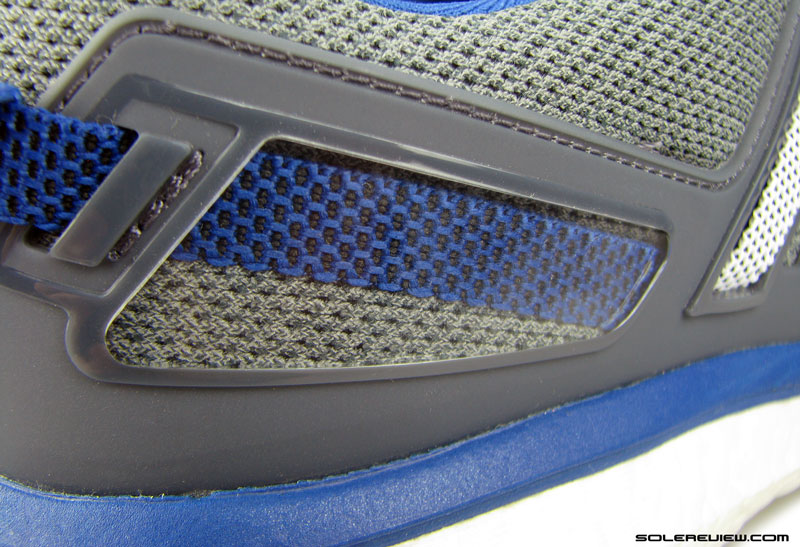
The heel sides have transparent windows; there are reports that this fogs up under certain weather conditions.
Other decorative trims worth pointing out would be the heel strap and the midfoot cage strap. The heel strap does nothing at all, and performs no other function than looking cool. And there are these transparent windows on both sides of the heel with the strap passing under.
It is a nice touch of aesthetic detail, though we read a comment elsewhere about how these windows fog up with moisture given certain climatic conditions. While we did not encounter that issue during our ownership period, we found that feedback interesting.
When we first saw images of the Energy Boost 3, our impression was, ‘Great. adidas has left the plastic cage in, but has included straps sitting over it. Those should slide freely over the cage, and allow some flexibility of fit which wasn’t possible on the EB2.’
But when the actual pair of the Energy Boost 3 came home, we discovered that the straps are fixed to the cage. So if you tug hard at the straps, the plastic cage bears down with even more intensity, so what’s the point of having these straps in the first place?
On a side note, the laces are too long, and have the tendency to slap around the sides as you run.
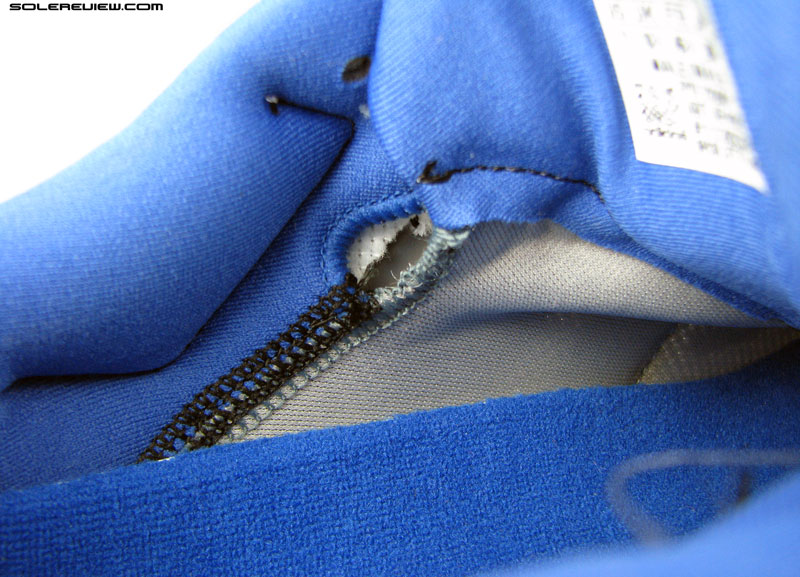
The Energy Boost has a bootie construction, meaning that the sleeve is seamlessly integrated into the upper.
The EB3 has the same inner sleeve and tongue design as before, except that the lining material has changed. The lining fabric is more in line with the mid priced Glide Boost, a smooth textile sans texture.
Most of the adidas line is moving to a raised ‘lip’ kind of upper collar profile, a design trend which started with the Ultra Boost. Recently, the Glide Boost got the raised Achilles dip treatment, and that basically results in two things. One, it makes getting in and out of the shoe slightly easier. The second effect is that the heel does not feel as secure as a non-raised design, though we’ve yet to experience actual slippage.
Details such as the ones mentioned above accounts for most of this year’s update, though to be honest we were expecting a lot more for a shoe refreshed once in two years.
A biennial update cadence is perfectly fine – though at this point we’re not clear whether the EB is supposed to be refreshed once a year, or once in every two. Assuming that it is two years, then theoretically speaking it gives the brand enough leeway to do justice to the updated version. But that isn’t true for the latest EB, because the Energy Boost 3 is a case of a step forward and two backwards.
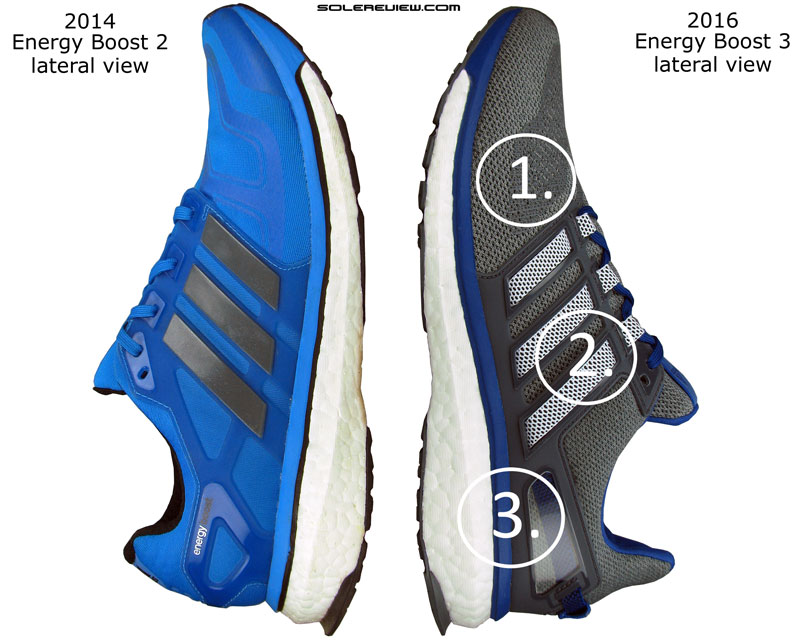
1) Wider forefoot due to fabric change 2) Midfoot cage – still there, and why? 3) A faux heel support strap and plastic windows are decorative updates.
While the forefoot fit update is very welcome, adidas hasn’t taken care of the much despised plastic cage. The Energy Boost has enough responsive cushioning to go for longer distances, but plastic cage sucks half the fun out of it. There isn’t any sharp poking sensation, but rather a feel of dull rightness around and over the midfoot. All of us could do without that.
And the outsole rubber – if it isn’t adiwear, what is it? Is it the same variety, but a softer kind, like the one used on the cheaper Response Boost? Time will tell how the Energy Boost 3’s outsole holds up.
Solereview recently wrote an article about what running shoes cost to make, where we found out that the actual cost to make the $160 Energy Boost 3 was lower ($30) than the featured packed Glide 8 Boost ($32).

The outsole edge which is meant to smooth out rearfoot strikes. The rubber used is different however, and might have a negative impact on its life.
It is very likely that a lower feature set, like the use of a non-adiwear/Continental rubber outsole, fabric lasting strobel and removing reflective trims results in a lower production cost. And to be honest, the latest Energy Boost 3 does carry the look and feel of a cheaper shoe than the EB2.
That’s all what we have to say about the Energy Boost 3. There was a time when the sheer brilliance of the Boost midsole steamrolled over many a shortcomings, but the landscape has changed greatly since the original Energy Boost 1.0 graced double page magazine spreads.
And that’s precisely the reason why solereview has rated the EB3 at 78 % instead of high 90’s – we’ve reviewed 100+ shoes since the EB2, and besides, the way we allocate scores has evolved too.
The long and short of this all is that you should get yourself a pair of the now-cheaper adidas Energy Boost 2.0 ESM, instead of the $160 likeness which the EB3 happens to be.
We wonder, though, if the design staleness is symptomatic of a larger issue – that of the lack of diversity within the walls of adidas’s head office.
Innovation becomes a rare commodity when everybody working at adidas HQ speaks native German. That issue is true for Japan as well, and it isn’t a coincidence that Asics and Mizuno haven’t been able to keep up. Business insider and racked wrote about adidas’s problem, which was based on a Reuters report. Interesting read.
(Disclaimer: For this review, Solereview.com bought the shoe at full US retail price.)
Looking to upgrade your old 2014 Energy Boost 2.0 to the latest version, but not sure how the 2016 model compares? We can help here. The following infographic is a ready-reckoner for what changes you might expect in the new model vs. old. To make this more fun, we’ve put in a system of percentage match, which calculates a weighted average for a set of attributes.
A higher or lower match percentage is neither good or bad. The % number just tells you how similar or distanced the new shoe is from the previous version. Total match % is a result of weighted averages.










